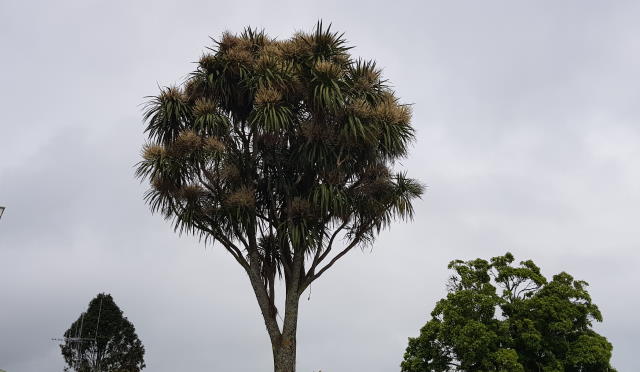Ti Kouka, Cordyline Australis.
There are 5 species of cabbage tree native to New Zealand, of which this is the most common. Once said to be the largest lily in the world, ti kouka has now been reclassified as one of the largest agaves, and thus a member of the asparagus family. Normally used in re-vegetation projects in New Zealand, in Britain it is planted in gardens large and small, often standing sentinel beside entrances and staircases, valued both for its exotic appearance and ability to withstand cold.
In Maori culture, the trees were highly revered, being seen as nearly immortal; when cut down, new buds will sprout from the corky bark. It was said that the trees were brought to Aotearoa from Hawaiiki and then planted around places of settlementwhere they marked paths, boundaries and urupa.
They were also a vital source of food for pre-European Maori, providing one of th emain sources of starchy, carbohydrate-rich foods. This was especially important in colder parts of the country where it was difficult to grow kumara. The clusters of undeveloped leaves, somewhat similar to an artichoke heartand known as koata, was helpful in digesting the rich fats from titi (muttonbird) and kereru. Even more important was the long, fructose-rich tap root, kauru. When harvested from small trees before flowering, they could be chewed like sugarcane, but the large ones were cooked en masse in huge umu. Taking a whole day to cook, the surplus could then be stored for the winter or carried as food for travellers and war parties.
The Meaning of Trees, Robert Venell.

Tī kōuka/cabbage tree Cordyline australis 2
Recently I wrote about the food value of the cabbage tree to Māori. This month we look at its value for weaving. Its stiff, robust leaves are a thorough nuisance when tangled in the lawn mower, but they provide some of the finest weaving materials in the country and are an excellent alternative to flax (Phormium tenax). Because the fibres do not shrink in water, they were often used by Māori to make fishing nets and ropes to anchor waka.
They were also woven into sandals (pāraerae), which could be made in different styles according to need. In rough terrain soft plants such as moss were incorporated to provide cushioning for the feet, whereas in grassy country or where there were spikey plants such as speargrass (Aciphylla horrida!) sandals were woven knee high to protect the legs. To help wade through heavy snow small woven mats were attached. Of course these pāraerae would wear out in a few days on rocky terrain, so when travelling long distances Māori would carry many pairs so they could be replaced when necessary.
The mountain cabbage tree or tōī (Cordyline indivisa), has a much broader leaf and is the best species for weaving rain capes. For extra waterproofing an additional under layer of overlapping leaves was used, somewhat like a thatch in reverse. A fine example of such a kahu tōī can be seen in the Auckland War Memorial Museum. Thus equipped with cape and sandals, and carrying a supply of cooked cabbage tree root, Ngāi Tahu were able to hike the routes through the Southern Alps to collect greenstone. (The Meaning of Trees, Robert Vennell)

